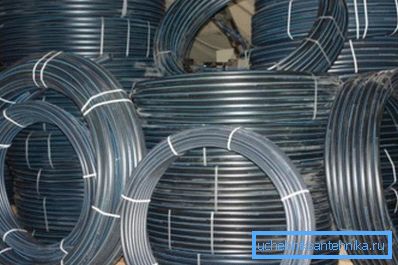Pnd water pipe: the main reasons for its popularity
PND water pipes for cold water supply have been introduced in some countries even at the legislative level. This is especially true for regions with high seismic activity. A good example in this case is Japan. What these products owe so much popularity, we will analyze in this article.

Technical description
Let's start with how the HDPE pipes for water supply are made:
Manufacturing process

PND is obtained from ethylene gas, which undergoes polymerization at a temperature that is only slightly above the boiling point of water and a pressure not exceeding 2 MPa, using such an exotic catalyst as, for example, a mixture of TiCl4 and AlR3. Then the resulting material passes one of the processing options:
| Method name | Description |
| Casting | The substance is placed in a characteristic shape that rotates and, frozen on the walls, forms a finished pipe. |
| Extrusion | Heated low pressure polypropylene is squeezed out of the mold, after which it immediately freezes |

Physical properties

Technical characteristics of HDPE pipes for water supply are as follows:
| Parameter | Value |
| Density | 0.94-0.96 g / cm3, less than water |
| Elongation at break | 500-600%, indicating a high elasticity |
| Softening temperature | 80-120 degrees |
| Withstand pressure | 4-20 bar |
| Possible diameter of pipes PND for a water supply system | 16-1600 mm |
Tip: It is not recommended to use low-density polyethylene pipe products for the installation of heating and hot water systems. Under such conditions, temperatures that are critical for a given material may occur, leading to an emergency.
Merits
We now turn directly to what advantages have plastic pipes for the HDPE water supply system:
- Relatively low cost. Plastic is always different cheapness in comparison with other materials.
- Small weight, which gives two positive aspects at once:
- Low costs during transportation, transportation of heavy steel is much more expensive;
- No need for reinforced fasteners and additional pressure on the building foundation.

- A simple installation instruction that can be carried out in one of two ways:
- Permanent connections. At the same time, “butt-welding” or electrofusion welding is used. As a result, the pipeline has a very high level of tightness and reliability, which makes it convenient for transporting liquids under high pressure. True, this process requires special equipment.

- Detachable connections. Here, special flanges are used for docking to connect pipes or sockets with elastic seals. Such connections are made even more simply, but are suitable only for non-pressure water pipes.
- High elasticity. The considered products are easy to bend with their own hands, taking almost any convenient form for conducting the pipeline. Especially it simplifies the task of cornering.
Tip: if you need to bend the HDPE pipe in a particularly unusual way, it is recommended to thread a metal spring into it. This will give the opportunity to keep the new form and simplify the process itself.

- Complete inertness to water, acids and alkalis. What does it mean:
- The absence of corrosive processes that are the scourge of metal products;
- The possibility of laying in the ground or even swampy areas without any additional insulation, and this is a significant cost savings and simplified installation work;

- The lack of transfer of their taste to the water, which is transported through the HDPE pipe.
- Very high throughput, which is higher than that of other pipes, by 10-15%. This completely eliminates the possibility of the formation of raids on the internal walls of the pipeline.
- Acceptable Strength There is no fragility inherent in PVC products.
- A wide range of all kinds of fittings and adapters, allowing the connection even with pipes of other materials. Permissible to create a water supply system of almost any complexity.

- High noise absorption. The sounds of flowing water will not interfere with your sleep or rest. This quality is especially valuable when arranging the sewer system.
- High frost resistance. They withstand temperatures as low as -70 degrees, which is convenient when stored in non-heated rooms and, again, when installed in unequipped trenches.
- Full sanitary hygiene. Freely used to transport drinking liquids.
- Durability. The created water supply system will serve you for several decades, because the plastic decay period reaches two centuries, and low pressure polyethylene is one of its most reliable representatives.
disadvantages
Before you do the water supply from the HDPE pipes with your own hands, it is fair to get acquainted with the few disadvantages of these products:
- Relatively low melting point, which we have already mentioned in physical properties. But precisely because of the same quality and possibly so simple soldering of polyethylene elements.
- Lack of resistance to ultraviolet rays. Being under the sun for a long time, the HDPE pipes lose their elasticity and become brittle. Therefore, to store these products preferably under the roof.

Conclusion
Low-pressure polyethylene pipes are distinguished for their high reliability, elasticity, resistance to chemical attack, frost resistance, and ease of installation. The combination with low price makes this material an excellent choice for creating a cold water system. No wonder the Japanese everywhere do. Unfortunately, PND pipes are not suitable for hot water supply, since they have a relatively low melting point.

The video in this article will provide you with additional consideration of some materials that are directly related to the topic outlined. Choose only the best when creating communication systems in your house or apartment.